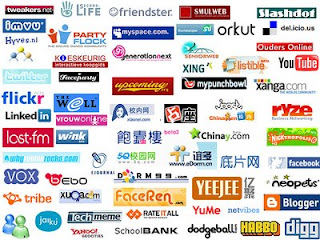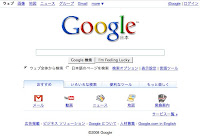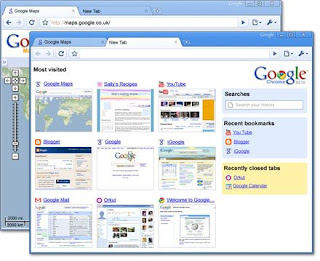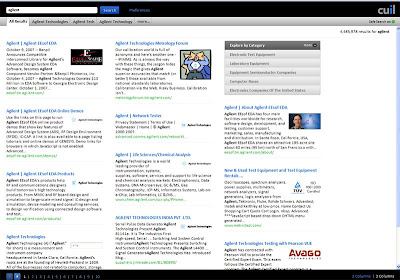Read more...
Google's personalised search changes SEO
Google is rolling out its customised search function to all of the search engine's users, affecting anyone involved in SEO.Previously only Google users who had signed-in and had enabled their web history on their account have found their search results customised. Now all users will find that if they favour a certain site Google will feature it higher in its search results.
Google says the aim of the move is to provide better search results to its customers. It will also be able to target ads more precisely by building a profile of its users web activity.
As search results will vary from user to user it will make it harder for SEO specialists and marketers to convince Google's algorithms to push a site higher up its search ranking.
A website's position in a Google results page will also be harder to analyse as it will vary from user to user.
Users can turn the personalisation off it remains an opt-out rather than an opt-in service, alarming privacy campaigners.
Read more...
Kent Building Group Limited acquires Ewom Marketing
Read more...
Promoting and Growing Podcast Listening Figures
First of all I must apologise for the lack of posts in the last couple of months, it’s been all go, but things seem to be settling down.
For this blog I’d like to spend some time focusing on podcasts. We often receive emails from not just from businesses, but people looking to promote online radio shows and podcasts. Of course podcast are an effective marketing tool, the easiest part is creating and publishing a podcast. The hardest part is getting people to listen to it. Therefore in this blog I have listed some effective methods I have used in the past to increase listenership:
1) Sell the visitor your Podcast & make it Search Engine friendly: Like anything you put on the internet which you want to attract people to, you need to ensure its search engine friendly. There are two key ways that people come across new information online: a link or through Search Engines.
First time visitors want a quick and summary about the podcast prior to investing their time listening. This summary will act as a sales pitch to try and convince visitors your podcast is worth their valuable time.
Make sure you subscribe to Your Podcast. By subscribing to your own podcast in Yahoo, MSN, Google Reader, and other online service will help the service knows that feed exists, If they have one customer subscribed to a feed, which means your feed is indexed by that service.
2) Use Press to promote your podcast: The use of online Press release services can help promote podcasts if there's an interesting angle in one episode of your podcast. If you have a special event such as a milestone episode, annual anniversary, interviews with interesting people or upcoming contests are all reasons to send out a press release.
3) Interviews: On a podcast it can be very worth well interviewing people in the topic area of your podcast. If you do ensure you send a link to the person you interviewed and encourage them to link to it from their own website, blog, or social network profile. By doing this will help other people in the interviewee's circle of influence find out about your podcast .
4) Two Way communication: While listening to audio is technically a one way communication, encouraging and incorporating listener feedback in your show creates a sense of community. Provide ways to contact the podcasts for feedback and questions and if you do get emails make sure you read them during your podcast. Link up web applications such as twitter and Facebook to your podcasts so listeners can become fans, and promote your show therefore creating E-WORD OF MOUTH.
Other advice is similar to methods of promoting blogs such as:
* Commenting on other podcasts, forums, and podcasts.
* Offer to guest blog on related blogs, when they need a break or want to go on vacation.
* Get Listed in both podcast directories and directories focusing on your podcast topic. There are loads of podcast directories out there some of the most effective ones I have found are:
Read more...
Too Twit or not too Twit?
 In the past few months, the world has gone Twitter crazy. It’s hard to watch a TV show or listen to a radio show without someone mentioning Twitter. This has resulted in more and more companies flocking to the 140-character micro blogging message tool to reach consumers.
In the past few months, the world has gone Twitter crazy. It’s hard to watch a TV show or listen to a radio show without someone mentioning Twitter. This has resulted in more and more companies flocking to the 140-character micro blogging message tool to reach consumers.In a recent report issued by PC maker Dell, it was revealed that they have had great success with Twitter. Since posting their first message on Twitter two years ago, Dell has generated over $3 million directly from its Twitter users, who reached their online sales website via a link on its Twitter posts.
This provides an interesting case study on how businesses can utilise web 2.0 sites to generate business. Although many question that when Dell generate a revenue of $12.3 billion in their first quarter in 2009, that $3 million, is not going to make too much of a difference for them. However it does highlight that social media is effective if the message is right.
From tracking Dell on Twitter, they seem to posts 6 to 10 times a week from its DellOutlet account. The way that Dell generates this profit from Twitter is simple, almost every post includes a voucher code, exclusive to Twitter, enabling them to track the campaign.
However businesses need to remember that Twitter does require some attention, its not a case of just sticking a message up twice a week. Twitter can be used to gather information, and interact with consumers by helping and giving them information, when they ask for it. If all you do with social media is use it for advertising, soon everyone is going to tune you out. I know for myself I tend to not pay attention to people that just self promote.
Read more...
The role and effectivness of e-marketing within the Visitor Attraction industry.
The report provides an overview of the attraction market specifically looking more closely at wildlife attractions, investigating the impact of the e-marketing, establishing core market factors, strengths and weaknesses, consumer dynamics and attraction trends. The main themes of the report are:
- How the growth of e-marketing has impacted the visitor attraction industry?
- What are the key e-marketing channels available for visitor attractions to use in their marketing strategies?
- What impact is e-marketing having on the visitor numbers?
- What future marketing opportunities are available for visitor attractions?
- What are the key target groups for attractions, what sources of information do they use?
- What does it take to get listed at the top of search engines?
- Plus find out what REAL Visitor Attraction marketing managers are doing, through the use of 2 case studies!
In addition the report includes guides on the following:
- Effective PR
- Tips for an Effective and Efficient Google AdWords Campaign
- How to Increase YouTube Video Viewing figures & Drive Traffic from YouTube to your website.
- Guide to making your blog successful
- Improving your Banner Click-Through Rate!
- and much more...
The increased usage of the Internet for both social and business purposes has revolutionised the marketing channels available to companies. These channels allow marketers to attract audiences using a pull strategy rather than a push strategy, utilising a more personalised approach. The developments within the world of e-marketing and web 2.0 technologies have also provided companies with platforms upon which they can interact with consumers.
For information on how you can get a copy of the report please contact Simon via email ewom@ymail.com
Read more...
Add E-Marketing into Your Marketing Mix Now
 The following blog lists a few simply methods to help though who have not yet started to include e-marketing into their marketing mix. By integrating a few of the following elements is a good start and by starting to include your website into your marketing plan you can drive new leads and generate new business that you wouldn't ordinarily reach using a single avenue of advertising.
The following blog lists a few simply methods to help though who have not yet started to include e-marketing into their marketing mix. By integrating a few of the following elements is a good start and by starting to include your website into your marketing plan you can drive new leads and generate new business that you wouldn't ordinarily reach using a single avenue of advertising.Web Address Inclusion
Your website can act as a point of reference for all of your leads and existing customers. Include your web address in all forms of your offline communication. If you post physical products, ensure that the packing slips and invoices have the URL of your website in a prominent position. Your website itself can be used to answer many questions that customers might have, reducing the time and even resource needed to respond to problems and questions posed by buyers.
Optimizing Landing Pages For On & Offline Leads
With any form of advertising it is vital to optimize your web landing pages. Optimizing a landing page means providing the content that your visitors expect. You should direct visitors to the most appropriate page on your website to answer their questions or to make a sale. If you use direct mail advertising and are promoting a specific product then direct visitors to the purchase page for that product. If you are offering your website as a place to get answers to questions or to resolve issues, direct them to the knowledge base or customer service page.
Using Online Advertising To Advertise Offline Business
While some businesses are run predominantly online, many websites are used to promote a bricks-and-mortar business. Whatever the purpose of your business, a website usually offers some form of advantage. The Internet is a global marketplace and provides a genuinely affordable method to promote even the smallest business. Very few other methods level the playing field so clearly between small businesses and large corporations.
Using Other Forms Of Offline Advertising In Your Advertising Mix
Newspaper and radio advertising provide a very direct form of marketing. Few websites can realistically afford television advertising but flyer's, direct mail, and less expensive advertising methods are a genuinely viable alternative. Again, the key to success in using these forms of advertising is integrating them within your online marketing mix. Only through good integration, directing visitors to the most appropriate page, and optimizing that landing page.
Read more...
National Hotel Marketing 2009 Conference - Riding the Recession with Effective PR
 This past week was very busy for me, attending not just the annual CIM (Chartered Institute of Marketing) Marketing Communication Lecture, but also on Friday I assisted at the Hotel Marketing 2009 Conference. The Hotel Marketing 2009 conference, as the name suggests focus mainly within the hotel/hospitality industry, however with guest speakers from Trip Advisor, and Superbreak both successful online companies, there was many useful topics and avenues discussed that could be applied to many industries. The 5th National Hotel Marketing Conference, took place at Heathrow on Friday 6th March and was attended by just fewer than 100 of the hotel industries top executives. The conferences theme was “riding the recession” and many presentations focused upon this. The day kicked off with a keynote speech with former head of the BBC Greg Dyke, throughout the day several workshops took place, one of the workshops that stood out to me was one conducted by Barbara Huddart, from the Glendale Consultancy & PR. The workshop hosted by Barbara looked at “Effective PR for Hotels” although much of what she presented could be applied to most companies and establishments, therefore I thought I’d give a rough overview of what was presented and add in my own thoughts.
This past week was very busy for me, attending not just the annual CIM (Chartered Institute of Marketing) Marketing Communication Lecture, but also on Friday I assisted at the Hotel Marketing 2009 Conference. The Hotel Marketing 2009 conference, as the name suggests focus mainly within the hotel/hospitality industry, however with guest speakers from Trip Advisor, and Superbreak both successful online companies, there was many useful topics and avenues discussed that could be applied to many industries. The 5th National Hotel Marketing Conference, took place at Heathrow on Friday 6th March and was attended by just fewer than 100 of the hotel industries top executives. The conferences theme was “riding the recession” and many presentations focused upon this. The day kicked off with a keynote speech with former head of the BBC Greg Dyke, throughout the day several workshops took place, one of the workshops that stood out to me was one conducted by Barbara Huddart, from the Glendale Consultancy & PR. The workshop hosted by Barbara looked at “Effective PR for Hotels” although much of what she presented could be applied to most companies and establishments, therefore I thought I’d give a rough overview of what was presented and add in my own thoughts.Effective PR
Basically PR is a strategic management tool to tell a good story, which can help to add value, and raises the profile of a company. Furthermore in times of recessions, where banks are tough on small businesses PR and consumers are quick to assume that businesses are in trouble if they don’t hear about them, PR can help send out a positive image to your bank manager & customers if they read about you in the press. PR is also a powerful tool to help secure the best knowledgeable staff, it will also help to increase staff moral within your firm within these poor economic times.
Many people view PR as something that appears in newspaper publications but it doesn’t have to stop there. No doubt your marketing plan is integrated ensuring that your marketing is reaching its full potential, your PR campaign should also take this form to ensure its effectiveness. Therefore the following methods/channels should be considered for effective PR:
· Articles - (shows an expertise within your company)
· Newsletters
· Company sponsors – (do the companies you sponsor have their own newsletters/publications)
· Speaking engagement
· Online PR
· Interviews
· Trade show/exhibition – (via the press room consider using freebies related to the Press Release)
· Competitions/offers – (effective method of getting good media coverage, and saves on advertising cost)
The most effective PR usually involves a story, which is one of the following: Topical, Unusual, Surprising and Reactive. PR revolving around one of these is more likely to be read then others.
Many newsworthy opportunities are available for companies to use as PR, here are just a small selection:
· Human interest stories,
· Staff Achievement ,
· Economy – (creating jobs),
· Celebrities/VIP visitors or users,
· Unusual happenings/ events,
· A rise in visitors or number of products sold.
· Strange, but true stories,
· Themes or Milestones,
· Charitable events or support,
· New Launches,
· Business development,
· Events & exhibitions – pre, during and post.
· Surveys,
· Awards/ Accolades.
The presenter spoke about how important it is to keep up to date with the latest trend to enable companies to use this to their advantage. PR which focuses on current trends or use “Buzz Words” are more likely to gain attention. This reiterates what I spoke about in one of my previous posts about using social networks to spot growing trends. A selection of the current “Buzz Words” can be found below:
Economy Credit crunch Carbon footprint Local
Good value Healthy Traditional Adventure
Experience Glamour British Cuddly
Warm Books Spring Cleaning
Tourism Boards can be an important channel of communication between you and the press. When press come to a certain area their first stop for information on the area is the Tourism Board therefore it is vital that those involved in the tourism sector especially, ensure that they send out their information to them. Consider creating a information pack that be issued to the press by Tourism Boards, include freebies! – free nights stay or free entry!
The internet is incredibly important and had a major impact on the success of PR, these statistics presented by Barbara reflect just how important.
· 92%of journalists use websites to research articles.
· 78% of journalists use websites to find new sources.
· 73% of users use websites just to access PR.
Due to these large statistics company websites should be very press friendly, therefore it is recommended that ALL company websites contain a Press Room. The press room should contain everything required you think that the press will require and more. From the simply things, such as the key PR contacts within the company, to company facts, case studies, and stories, a great tool to develop is a media fact sheet, which will provide all the information the press could require. This could contain company facts and history, strange, but true stories, a timeline of events, however make sure your company USP is clear and can be identified from the start.
Remember pictures speak 1000 words and a simple photograph can breathe life into a story; therefore always send a photo along with a story. A photo containing a person also has more potential of being used by press. Also ensure if you have images online you make them high resolutions so that press can use them in printed format.
Finally it is important to stay ahead of the trends curve, for example the next Harry Potter film is released this year, therefore companies should be planning to see if there is an opportunity which they can capitalise on.
Read more...
3rd Annual CIM Marketing Communication Lecture - Panasonic, Thorpe Park & MediaCom marketing in 2009
 On Wednesday 4th March 2009, I was able to attend the 3rd Annual CIM (Chartered Institute of Marketing) Marketing Communication Lecture. Session proved very useful and a great opportunity to see how three large companies are coping with the current economic climate. Guest speakers included:
On Wednesday 4th March 2009, I was able to attend the 3rd Annual CIM (Chartered Institute of Marketing) Marketing Communication Lecture. Session proved very useful and a great opportunity to see how three large companies are coping with the current economic climate. Guest speakers included:Branded content usually takes the form of sponsorship or branded TV. An example for the UK readers is the transmission with T-mobile show on Channel 4, which achieved great success as a TV show, gaining repeats within the channel. As well as branding the show title, brand colours and logo were used within the show. Furthermore a range of other forms of communications were used such as street gigs for T-mobile customers, dedicated sections on social network site Bebo, all these promotions and the TV show generated 25+ articles a week.
Therefore it appears amplification is the key, and that branded media needs to be supported through a selection of other types of marketing, such as websites, PR, in store and packaging promotion to name a few. Within the current climate television stations are crying out for programming, and as a result they are asking brands to help fill/fund main time slots. Traditional television is also facing competition from online web players, which face fewer rules and regulations. “Bebo“ created an exclusive online drama, which companies paid to sponsor and brands were integrated into the story lines. MSN video will be following Bebo’s example and is creating an exclusive sci-fi web show. BMW also created a series of online shows starring actor Clive Owen.
A great example of branded media is a campaign AXE launched in the United States, called the game killers. Make sure you watch this YouTube video for more information on the whole campaign and how effective branded media can be.
Branded media is all about engagement with your target market, its main purpose it seems is to amplify your brand, rather than just stick to the TV with an advert and hope that something comes from it.
2) The second presentation was from Rob Healey the Head of European Marketing for Panasonic System Solutions. Rob highlighted how much more challenging Marketing would be in 2009, identifying the following issues:
· Shrinking Economy
· More competitive market –survival of the fittest
· Increased unemployment – Less consumer spend
· Changing exchange rates
· Reduced business confidence due to deflation
· Rise of Protectionism
For a company like Panasonic, which mainly deals with B2B clients, its marketing strategies differ from that of a B2C company. Panasonic focuses heavily on relationship marketing, and to ensure the successful communication of product specifications. This is completed through specific targeted marketing to generate leads. Rob noted that Panasonic are suffering from the economic climate and have implemented regulations within the company to control costs with constant budget reviews. In addition more time is spent on assessing and analysing, ensuring a high ROI. Panasonic are currently only exploring avenues that guarantee strategic development and advancement, resulting in slower reactions to marketing opportunities.
Panasonics key marketing during 2009 is still heavily focused upon building relationships with clients, through exhibition, reassuring consumer have confidence in their products. Telemarketing is also important, capitalising on the contact made at exhibitions. PR and advertising still remain important, however a growth in the use of case studies and press releases will be used due to the assumption that these are stronger then adverts, adverts will remain present to make sure brand is still present in the market. If they disappear this could impact client confidence, as they could presume the brand is in trouble. With that said all these methods have been cut in some volume by Panasonic, see below:
Exhibitions 43%
Advertising 50%
PR 39%
Telemarketing 22%
It was clear from the presentation that ROI was centre of attention more than ever, all marketing activities need to show that they served a purpose and that the decision process has increased immensely. It was also apparent that even large companies such as Panasonic are preparing for a weak year(s) through restructuring to save on costs.
3) The third presentation was from Andy Le Duc, the Brand Manager for Merlin’s UK Theme park Thorpe Park. Thorpe Park currently position themselves as the nation’s thrill capital, and with over 25 rides and attraction and the launch of the new SAW ride this month continue to be positioned as the UK’s market leader. The parks target market is thrill seekers aged between 16 -24, who are as Andy called it “up for it”. The vision for the company is that they become the No. 1 Entertainment company (currently 2nd after Disney)
A number of key points came out of the presentation regarding the state of the Visitor Attractions market in 2009:
· Induction of positive effect caused by economy – Growth in day trip market
· Record numbers holiday at home
· Merlin showing visitor number growth compared to 2008.
· 16 -24 audience are less exposed to the recession
· Secondary spend at risk, due to customers planning ahead, Thorpe Park has seen food and drink sales dip in early 2009.
· 74% trying to reduce holiday spending, this has resulted in a growth in advance bookings.
· Increased competition for leisure time from other activities.
With these points in mind Thorpe Park have set themselves the following challenges for 2009:
· To sustain growth, whilst ensuring yield is maximised.
· Drive volume through promotion - currently only 6% pay full price.
· Deliver a fool proof media strategy – decline in the use of new ideas.
· Encourage secondary spend
· Focus on customer retention and loyalty schemes
· Maximise on the growth of UK holidays
To reach these targets Thorpe Park are using the following strategic planning tools:
· Grow penetration and catchment area with large scale media
· Destination positioning through the use of packages (long term aim)
· Focus on annual passes – large secondary spend
· Maximise link with Saw brand – merchandise and fast-track passes.
The Saw ride was a major part of this presentation and it could be viewed that this presentation was largely used as a marketing opportunity. The Saw ride incorporates many firsts for theme park rides, and is the only one of its kind in the world, therefore a major USP for Thorpe Park.
The launch of the ride takes place this Friday (13th March) and has been in planning for 3 years. Thorpe Park has set themselves the following challenge for the launch:
· Balance the Thorpe Park brand and position with the Saw brand
· Drive 2 million visitors through the gates; this is 200k more than in 2008.
· Generate more than 5.4 million pounds worth of revenue.
· Increase yield through promotion.
· Increase penetration - grow age footprint of the park.
· Position as thrill capital
The launch campaign will come to an end at Halloween when Thorpe Park aim to make the ride an 18 certificate the first in the world. A great venture by Thorpe Park and they will no doubt smash their targeted visitor numbers, although the park does have a risk of negativity within the press for creating such a scary ride aimed at over 18s, all PR is good PR.
Although all three companies differ completely it was interesting to note that the first two were very negative about the economic problems currently affecting the world, but Thorpe Park is benefiting from it. It is stated that within stressful time’s consumer do spend more on leisure to try and forget their troubles. It will be interesting to see how Thorpe Park are doing this time next year when the launch of the Saw is over and which methods they will implement to sustain the visitor numbers achieved with the help of a new ride.
Read more...
Using LinkedIn to promote your business
 After logging into LinkedIn for the first time in several months, I thought considering how successful they have been and the huge marketing push it received in London I should really have identified and wrote about the marketing opportunities it provides.
After logging into LinkedIn for the first time in several months, I thought considering how successful they have been and the huge marketing push it received in London I should really have identified and wrote about the marketing opportunities it provides.For those who haven’t heard of LinkedIn, it is a social networking website that is geared specifically towards business members. It enables users to build up a network of existing and new business contacts (called connections). Wikipedia reports that LinkedIn has more than 20 million registered users and attracts over 3.2 million visitors every month in a total of more than 150 different industries from all across the globe. LinkedIn is more closely matched to offline business networking than virtually any other social networking website. It can be used to keep contact details while building a strong network but other users predominantly use it to make contacts and secure future employment. Conversely, many employers and agencies use their network to find suitable candidates for work. The key USP to LinkedIn is that when you add a new connection, their connections and the connections of those connections will also be added to your network, if that makes sense! Providing you with an impressive network of business contacts.
Read more...
Social Networks are not just for advertising - Spot trends and Opportunities
 Identifying and acting on trends is important in every business. It helps to identify new opportunities and provide insight into a more effective marketing strategy. Trends provide you with the opportunity to steal a lead over your competitors, especially if you learn to quickly identify the early signs of a new trend.
Identifying and acting on trends is important in every business. It helps to identify new opportunities and provide insight into a more effective marketing strategy. Trends provide you with the opportunity to steal a lead over your competitors, especially if you learn to quickly identify the early signs of a new trend.One of the biggest trends in the past few years, which many companies capitalised upon, was social networking. Now social networking is one of the biggest things on the Internet. Video sharing sites like YouTube and social community sites like Facebook, and MySpace have become the most viewed and used sites. Due to their popularity, they can also be a good starting point to help identify trends. Remember to keep an eye on your competitors. Ensure you find out what they are doing, what offers they are currently running, and whether they have any new product launches.
Furthermore look at the communities where they are most active. Being first to a new trend is an advantage but, failing that, coming in late allows you the opportunity to better your competitor's efforts. Look for areas where you believe you can improve it. Finding out where your competitors are advertising or networking will lead you to the sites or opportunities that present relevant information. The more sources of potential trends you can find, the more accurate your data. You should be an active and eager member of the communities within your industry so use this information in tandem with the information you manage to dig up.
Identifying new opportunities can be a difficult task (and long), but by getting involved in markets and networking in relevant circles you will begin to identify the most relevant topics for your niche. This can help to increase market share and strengthen your brand by being the first to provide a new and wanted product or service. But remember as I mentioned before, if you do find yourself behind your competitors, you then have the chance to improve on their efforts.
Read more...
Your Company's Reputation at Risk....Online!
 According to recent data shown in the ‘Risky Business: Reputations Online', Sixty seven per cent of companies are at risk of damaging their reputation online. The survey was conducted among senior executives in countries around Europe, North America and the Asia Pacific half way through 2008. The survey by PR company, Weber Shandwick found that this concern came from two main sources: misdirected emails and employee sabotage.
According to recent data shown in the ‘Risky Business: Reputations Online', Sixty seven per cent of companies are at risk of damaging their reputation online. The survey was conducted among senior executives in countries around Europe, North America and the Asia Pacific half way through 2008. The survey by PR company, Weber Shandwick found that this concern came from two main sources: misdirected emails and employee sabotage. Read more...
Localisation: Operate globally, think locally!
 Just because your website has had great success in your domestic market, it does not guarantee the same success internationally!
Just because your website has had great success in your domestic market, it does not guarantee the same success internationally! At the beginning of the computing era, programs were written only in English, the problem being that at this time only people who spoke English as their mother tongue, or who had studied the language to a high degree at school could access these resources. Therefore millions of potentially lucrative customers were lost as they could not understand the programs.
If you are looking to enter international markets it is crucial to translate your website into the language of your target market. A product or service on your website will appear much more attractive if it is presented in the language of your target customer, whilst also allowing you to compete with locally produced products or services. Research has shown that web contact time is doubled on sites which have been correctly translated. But it is not all about language, knowledge of the cultural and business norms is necessary for successful localisation and international marketing.
Problems can occur with the design of internet forms designed to gather data from customers. In the English speaking world there is often no field on such forms for academic titles such as Professor or Doctor, but research shows that customers from European countries such as Germany and Italy respond more to direct e-marketing when they are addressed as Professor or Dr....
Another common problem with international internet forms is the postal code field, as postal codes come in various forms in different countries. The American field “State” also causes problems in Europe, as many countries are not split up into states. There have also been cases, where in order to proceed with an order the customer has to choose a state from a predetermined list! Confusing or unclear fields in an online form not only irritate the customer but they can also lead to inaccurate or incorrect information, meaning that the entire reason for the form is invalid.
The internet offers a great advantage in that you can go and check out how local competitors construct their sites before implementing any changes to your own, so get researching.......
Read more...
E-Marketing could have saved Woolworths!
 The collapse of Woolworths is by far the largest retail failure this year, symbolising the high street's woes, this is a major blow to all those involved within the retail sector.
The collapse of Woolworths is by far the largest retail failure this year, symbolising the high street's woes, this is a major blow to all those involved within the retail sector.Read more...
The YouTube Advertising Steam Train – YouTube Live, Adsense, Overlay ads, Sponsered videos and size!
 Since YouTube officially launched in December 2005, it has attracted users at a meteoric rate. YouTube receives 71 million unique users each month and has the 6th largest audience on the Internet. No longer is Online Video the future, it's the present: 75% of Americans watched a video online last month. With YouTube usage still high, Google have been working hard to increase the advertising opportunities and trying to increase the overall experience of the site. Therefore this month has resulted in YouTube unveiling a host of new advertising methods for advertisers:
Since YouTube officially launched in December 2005, it has attracted users at a meteoric rate. YouTube receives 71 million unique users each month and has the 6th largest audience on the Internet. No longer is Online Video the future, it's the present: 75% of Americans watched a video online last month. With YouTube usage still high, Google have been working hard to increase the advertising opportunities and trying to increase the overall experience of the site. Therefore this month has resulted in YouTube unveiling a host of new advertising methods for advertisers:YouTube Live:
It was only a matter of time before YouTube introduced live streaming/webcasting and on November 22nd YouTube hosted its first ever live event, the event featured a range of performers whose videos on YouTube had gain more then 2.5 million views each. With this being the first of many live events YouTube has in store, how long before sponsorship opportunity for these live events becomes an option?
YouTube Adsense:
When searching the site users will now be greeted with video advertisements similar to those produced by Google AdSense. YouTube searches now produce "sponsored links" on the right side of the screen alongside unpaid results on the left.
YouTube announced a deal with MGM studio's to show full-length television shows on the site. Where this will bring a lot of money in for YouTube is that advertisers will be trying to outbid each other for the advertising space next to these videos. Through increasing the amount of professional content on the site, they are aiming to increase the amount of advertising by double. YouTube has struck similar deals with CBS and Lionsgate, so one would presume YouTube advertising isn’t as popular as Google had hoped and sees this as a way to increase this. When YouTube first launched its Advertising schemes advertisers were reluctant to use this channel due to a concern regarding the site consists mostly of amateur videos, and companies didn’t want to risk damaging their brand by being associated with these.
YouTube Overlay ads:
YouTube will also now begin running overlay ads in YouTube partner videos that live on other sites. This means that no matter where a YouTube video is embedded, it can contain an ad and earn revenue for YouTube partners.
YouTube sponsored videos:
YouTube Sponsored Videos allows anyone to promote their videos on the search results page. Bidding on specific keywords will promote your video to the right-hand side of YouTube’s search results along with an image and some text. Again similar to Google Adwords. By being able to target YouTube videos, advertisers will be able to give the most visibility to their videos.
According to YouTube this was launched due to requests of businesses. Of course one would presume that due to YouTube being ranked as one of the top five search engines this had a great deal to do with this. But it seems that this no longer is the case as its hard to find a video that doesn’t have a sponsored link on the right hand side.
YouTube Today also announced another change – the size of their video player. They have expanded the width of the page to 960 pixels to increase the quality of the videos. A new wider player is in a widescreen aspect ratio which is hoped to provide a more powerful viewing experience.
For more information on YouTube advertising check out this link, http://uk.youtube.com/t/advertising Also please note that only some of the YouTube Advertising channels are currently only available in the U.S.A.
Read more...
Can Social Networking sites make or break product marketing?
 Social networking is having a significant effect on the way that consumers now search for information about products and services they wish to buy. Consequently, this has huge implications for the marketing strategies of firms.
Social networking is having a significant effect on the way that consumers now search for information about products and services they wish to buy. Consequently, this has huge implications for the marketing strategies of firms.Read more...
Internet Based Market Entry
 Yesterday I came down with a case of the Mumps, therefore I have the time to put something together on firms using Internet based market entry. Enjoy!
Yesterday I came down with a case of the Mumps, therefore I have the time to put something together on firms using Internet based market entry. Enjoy!The Internet provides a market entry method that is particularly suitable for smaller, widespread niche markets. Whilst websites might be accessible worldwide, however, the firm may need to select markets to focus on, possibly excluding those where there may be particular barriers, such as language, legal, payment and over fulfilment problems. The cost of organising to serve certain markets might outweigh the possible benefits. For firms that already have a strong presence in many markets the Internet supports all aspects of their activity.
Web based services will be successful if firms develop a global strategy based upon the integrated value chain. As this is a pervasive method of entry, based on global communications, it can facilitate lower risk access to difficult markets. By building online delivery capability it is possible to service markets profitably where there might be limited demand. of course, an e-commerce strategy is limited scope simply because it appeals to a very specific transnational segment - those that are able to gain access, particularly high speed access, continues to grow this is a diminishing problem.
Read more...
Localising websites around the world...a little help!
 After attending a conference in London last week, I was lucky enough to meet a "Localisation Outsourcer Consultant" A type of consultant I hadn't heard of before, therefore I was eager to learn more, with my notebook at the ready I began to "network"..
After attending a conference in London last week, I was lucky enough to meet a "Localisation Outsourcer Consultant" A type of consultant I hadn't heard of before, therefore I was eager to learn more, with my notebook at the ready I began to "network"..Read more...
Google Video aim to do what YouTube did in the consumer world, only for the enterprise.
 Google is now started to target corporate users with its release of "Google Video for business", the newest addition to the Google Apps package. Google's aim for this application is to address the requirements of corporate videos. For example, executive communications, product training and reports.
Google is now started to target corporate users with its release of "Google Video for business", the newest addition to the Google Apps package. Google's aim for this application is to address the requirements of corporate videos. For example, executive communications, product training and reports.Read more...
Quick facts about Google Chrome!
 For those interested in internet marketing and advertising, anything that Google does catches our attention. Also having a great interest in online marketing, internet broswers is something that I always keep an eye on as I everyday without fail I use one. In recent years, Microsoft Internet Explorer and Firefox browser are the 2 most popular web browser use by internet surfers.However over summer Google came out with a new internet browser which is set to compete with Microsoft Internet Explorer. When Google announced its new open source browser, everyone sat up and took notice.
For those interested in internet marketing and advertising, anything that Google does catches our attention. Also having a great interest in online marketing, internet broswers is something that I always keep an eye on as I everyday without fail I use one. In recent years, Microsoft Internet Explorer and Firefox browser are the 2 most popular web browser use by internet surfers.However over summer Google came out with a new internet browser which is set to compete with Microsoft Internet Explorer. When Google announced its new open source browser, everyone sat up and took notice.The new Google browser is called “Google Chrome“. Here are some of the features of Google Chrome:
1) New Tab page
2) Application shortcuts
5) Incognito mode
6) Safe browsing
7) Instant bookmarks
8) Importing settings
9) Simpler downloads
“We think of the browser as the window to the web - it’s a tool for users to interact with the web sites and applications they care about, and it’s important that we don’t get in the way of that experience,” said Sundar Pichai, Vice President of Product Management, Google Inc. “Just like the classic Google homepage, Google Chrome has a simple user interface with a sophisticated core to enable the modern web.”
Speed is the key feature for me and Chrome is built for that. While Chrome beats Microsoft's Internet Explorer on speed, it doesn't do the same when compared with Firefox or Safari on such frequent tasks as launching Web pages. The big question is whether as they will add more and more to it as remember this release was only the beta, will this mean that performance will take second stage to features.
Read more...
A Quick Web Development Guide
 These basic steps below will help when developing a website, it ask a number of important questions that should be address to enable you to develop an effective website.
These basic steps below will help when developing a website, it ask a number of important questions that should be address to enable you to develop an effective website.1. Define the site's goals and audience
What content is available now? What needs to be developed? (Content should be high quality, clear and interesting -- the best content you have available.) What content will you include with the site's initial release? What content will you add later? Do you have illustrations, photos or other graphic images available in addition to text? What content will be updated over time? How often will the site be updated? What existing content should be redesigned to fit the web (avoid as much as possible "shoveling" existing content onto a site).
5. Identify owners for the following roles
Project manager: Responsible for getting the initial site launched.
It is not unusual to have a webmaster take several roles.
6. Find existing websites that you like (and dislike)
7. Consider ways to organize your content
8. Make it interactive
9. Check in with your users
10. Identify designers and get Quotes
11. Bring the designer into your process
12. Review design concepts
Share them with your user group and incorporate feedback into design refinements.
13. Select a design and prototype
14. Test publish the site and test the prototype
15. Create a marketing plan
16. Create a maintenance plan
17. Launch!
Finish the HTML, graphics and additional programming on the full site. Publish the site. Market the site.
18. Get feedback
Collect feedback and incorporate feedback that makes sense.
19. Conduct follow-up studies and improve the site
Read more...
Questions, Questions, Questions - Back to Basics!
1) Why isn't my website the top result in Google?
2) How do we get to be the top result?
Therefore below I attempt address these question with a answer that even people who are new E-Marketing will understand:
To answer these questions you must understand Search Engine Marketing (SEM). These are the strategies used to be the top search result on Google, Yahoo or any other search engine.
Gaining a top search result is critical to most companies this is because almost all customers will begin their investigation on the web.
There are two ways to get onto the Google pages: "organic" and "pay". Basically the organic listing is free and is based on Google's search algorithm that finds the best page based on your search criteria. It is in the main section of the Google page (see orange box on graphic below). The challenge is how to get on the top organic listing. The Google algorithm is a trade secret and the company does not tell anyone how they decide on the top reach results. It is widely assumed that the organic listing is influenced by two things:
1) How often your page is referenced by other sites
2) The popularity of your page.
The key is to be listed within the top 20 searched, which is commonly referred to as "Being on Page 1". 80% of users never go to Page 2. (Personally, I don’t even look beyond the top 5 search listings)
The purple and green boxes denote where companies pay for placement. This is commonly known as Pay for Position, or P4P. It is basically a bidding contest. Every company decides which words they want to "buy" and then decide how much to pay. The company paying the most gets the top position.

Read more...
Mercedes Benz Screws up..........
 Making people take note of Direct mail advertising has become a bigger chanllenge then ever! Most people screw it up as soon as they set eyes on it! But Mercedes Benz (UK) have saved them that job. Mercedes Benz has created a new direct mail campaign in the form of a scrunched up paper ball.
Making people take note of Direct mail advertising has become a bigger chanllenge then ever! Most people screw it up as soon as they set eyes on it! But Mercedes Benz (UK) have saved them that job. Mercedes Benz has created a new direct mail campaign in the form of a scrunched up paper ball.The new insert is targeted at garages and mechanics, encouraging them to use only Mercedes parts to repair customers' vehicles.The insert arrives in foil, and can be straightened out, to reveal the strapline:
Read more...
12 Tips for an Effective and Efficient Google AdWords Campaign
 Google AdWords (P4P) is the online marketing tool that businesses invest the most in. When I first started using Google AdWords, I had an extremely low budget, therefore I really had to ensure that my plan was efficient and effective. Therefore with the help of books, journals, tips and reports I put together a list of key essentials that if followed will help YOU run a more successful Google AdWords campaign.
Google AdWords (P4P) is the online marketing tool that businesses invest the most in. When I first started using Google AdWords, I had an extremely low budget, therefore I really had to ensure that my plan was efficient and effective. Therefore with the help of books, journals, tips and reports I put together a list of key essentials that if followed will help YOU run a more successful Google AdWords campaign.1. Don’t use broad terms and keywords
If you include very general keyword or phrases, for example such as “football shoes”, in your keyword list, your ads will appear when users search for football and shoes separately as well. You should use very specific keywords which will also save costs as a lot of general keywords have a high click price.
Using keywords like this is usually used by experienced advertisers who also have a long list of negative keywords. It often gets a bad rap, but there are times when broad matching can work well, but only when using together with negative keywords.
Dynamic titles are easy, they don't cost anything and they usually have a good effect on CTR and conversion rates. The phrase that the searcher uses in their search will come up as the title of your AdWord. This saves you having to create an individual ad for each keyword and means that your ad will be more targeted. In the title field of your ad simply your keyword first, then a backup/follow up title. However If all your competitors are using Dynamic titles, then using a static title can make your ad stand out compared to the others.
If you're selling something, you don't want people finding your ad if they're searching for free stuff. This sounds obvious, but do some searches and you'll see it happening. Use the word 'free' in your campaign global negatives. You can also use this for other words you don't want to turn up for. Using negative keywords is especially important if you're using broad matching.
Everyone tries to reach to be the top ad on the list but you got to think just how much of a difference will being in the first position, as opposed to the second, third or sixth position make? If you are creative then it doesn’t matter on your position.
Track everything. Google will track impressions, clicks and click through rate. Just because an ad has a high CTR doesn't mean that it is making you money! If you don't know how each keyword is performing – then you won't be able to optimize your campaigns, by turning off the keywords that aren't working and investing more in the keywords which are.
It is easy to get into bidding wars with your competitors. You want to be number one and so does your competitor. This is the last thing you should do unless you can justify it. Let your competitor be number one, and be happy to be number two. Remember if you have a better product, your click through rate will get you to the top and you'll still be paying the same as you were in the second position.
When you're first starting out this is really important. Google AdWords is very addictive, and before you know it you have spent a week’s budget in one day! Set a weekly/ monthly budget and stick to this.
By targeting individual countries and even cities, this will make more targeted users feels that your ad is meant for them. If you have the advert in the local language this would improve your advert even more, and the more likely they are to click on it. Just remember you would have a English printed advert in Japan, AdWords is no different!
If you have your ads active 24 hours, your ads may be wasted on “Midnight Clickers” By choosing specific times for your ads to show this will help save money and ensure that you are targeting your specific customer more effectively. For example if I was targeting office stationary buyers, I would set my ads to run from 7am to 8pm, rather than have them running 24 hours.
11. Keep your campaigns organized
This will make it easier for you to know what is doing well and what isn't.
Remember before you begin and throughout your campaign you should take a look at what your competitors are doing. Are they doing something better than you? What keywords do you share with your competitors? Can you discern their strategy? Do they use automated bidding software? Do their landing pages have some magic which you should be emulating? This is the sort of stuff you can find out and the kind of stuff that you need to know.
Read more...
It's Cool To Use Cuil - But Does It Work?
 Former Google employees have launched a new search engine in an attempt to rival Google. Cuil claims to index three times as many web pages as any other search engine.
Former Google employees have launched a new search engine in an attempt to rival Google. Cuil claims to index three times as many web pages as any other search engine.Cuil, pronounced cool, uses about 120 billion web pages to create its index of information. What's with the name Cuil? Well Cuil is Gaelic word meaning knowledge! The site's founders claim that this is more than Google uses, however, Google has stopped reporting how many it indexes.
Cuil's uses search technology which ranks results by the content on each webpage, not by its popularity. It then carefully organizes similar search results into groups and sorts them by category. The results are displayed in a magazine style format, rather than a list. The site looks very boring and lacks colour, It appears that they are trying to stick clear of looking anything like Google as the site is almost the polar opposite of Google, using a black background with grey and blue colours.
Cuil's technology was developed by a team led by Tom Costello and Anna Patterson. between the two of them they have developed search engines at Stanford University and IBM, and worked for Google. Russell Power, Patterson’s former colleague from Google is also involved and is a co founder of Cuil.
Costello stated the follow when Cuil was launched: "The web continues to grow at a fantastic rate and other search engines are unable to keep up with it. Our significant breakthroughs in search technology have enabled us to index much more of the internet, placing nearly the entire web at the fingertips of every user." Unlike Google, Cuil does not keep any personally identifiable information on users or their search histories. Due to the site's search method, personal data collection is unnecessary.
I gave it a try and will not be using it again anytime soon. It brings up loads of results, but unfortunately they're mostly irrelevant and useless. I really like the format, but who cares what it looks like if it doesn't work well! It seemed to have a major problem when I searched for more than one word. In some cases it couldn't even find any sites! whole Google showed 830 sites for the same keyword I searched......and they were relevant.
Read more...
Facebook To Get A New Look!
 Facebook has been in the news almost every week for the past month! A couple of weeks ago it was because of Mircrosoft and Facebook agreeing on an advertising deal! Then only yestaday Facebook was accused of promoting volience, because one of applications allows users to virtually stab each other!
Facebook has been in the news almost every week for the past month! A couple of weeks ago it was because of Mircrosoft and Facebook agreeing on an advertising deal! Then only yestaday Facebook was accused of promoting volience, because one of applications allows users to virtually stab each other!However the major story that really caught my eye is that according to early reports Facebook will undergo a revamp in the next 2 months. The new look Facebook will feature a simpler design. But Facebook are tasking careful precautions not to make any sudden changes. Facebook will be inviting users to preview and use the new design and try out the improved features by navigating back and forth between the new and current versions of the social networking site. Access to the new design will be limited at first, but over time will become available to all users. The new Facebook design will be made available to users under the following URL: http://www.new.facebook.com/.
Brand republic report that among several new features will be included in the revamp. This includes a "publisher" feature which enables users to create content in a centralised area allowing users to add photos, upload video, or write notes, rather than navigating to each individual application. Also facebook are keen to tidy up unwanted applications/widgets by allowing users will have the option to interact with an application before adding it. Therefore allowing users to decide if they actually want the application on their profile and if they do, where. Facebook founder Mark Zuckerberg stated that the new design will make it a lot easier for users to share information.
Why change a winning formula? Facebook should concentrate in making Facebook more international friendly, It may be the most popular social network group in the UK and U.S. elsewhere in the world Facebook doesn’t dominate the social network universe.
Read more...
A Look at Facebook's Advertising Solutions
 Social networking sites have become extremely popular all over the Internet today, and are being used for much more than simply meeting new friends. Many businesses are realizing that social networks can be a powerful way to tap into a huge potential customer base. As every now knows Facebook launched their much awaited advertising solutions earlier this year. But why advertising through Facebook? A common complaint from many companies is that their advertising is not reaching the right audience. Instead of creating an advertisement and hoping that it reaches the right customers with Facebook, companies can select the age, sex, interests ensuring they reach the right audience. In a previous blog I spoke about how to create a Facebook page for products. In this blog however I will take a look at the complete Facebook advertising platform and capabilities.
Social networking sites have become extremely popular all over the Internet today, and are being used for much more than simply meeting new friends. Many businesses are realizing that social networks can be a powerful way to tap into a huge potential customer base. As every now knows Facebook launched their much awaited advertising solutions earlier this year. But why advertising through Facebook? A common complaint from many companies is that their advertising is not reaching the right audience. Instead of creating an advertisement and hoping that it reaches the right customers with Facebook, companies can select the age, sex, interests ensuring they reach the right audience. In a previous blog I spoke about how to create a Facebook page for products. In this blog however I will take a look at the complete Facebook advertising platform and capabilities.Facebook Pages:
This capability is for companies trying to create a brand image inside Facebook. Obtaining a Page is free and it is great for businesses such as: bars, pubs, music artists, and sports teams. It allows businesses to connect with customers on Facebook similar to the way users connect with their friends. Through a Facebook Page, users can show their support by becoming a fan, writing on your Wall, and other actions that automatically generate News Feed stories. Once joined advertisers can send updates to fans such as special news or offers. You can also link the page to your Facebook social ads.
When your fans interact with your Facebook Page, the actions they take are automatically generated into social stories. These stories are published to News Feed, which friends may see the next time they log into Facebook. The stories link back to your Facebook Page, inviting more people to interact with it, which generates more social stories and drives even more traffic to your Page. Viral marketing at its best!
Facebook social ads:
Facebook Social Ads allow your business to become part of people's daily conversations. Ads can be displayed in the left hand Ad Space, visible to users as they browse Facebook to connect with their friends, as well as in the context of news feed attached to relevant social stories. The social stories, such as a friend's becoming a fan of your Facebook page or a friend's taking an action on your website, make your ad more interesting and more relevant. Social Ads are placed in highly visible parts of the site without interrupting the user experience on Facebook.
Facebook Beacon:
This function allows customers to share with their friends the actions they take on your website. For user actions you define, Facebook Beacon will publish a story in the user's profile and to friends' news feeds with a link back to your site. Facebook Beacon actions include purchasing a product, signing up for a service, adding an item to a wish list, and more. When a user performs the action, they will be alerted that your website is sending a story to their profile. Facebook Beacon enables your brand or business to gain access to viral distribution within Facebook. Stories of a user's engagement with your site maybe displayed in his or her profile and in news feed. These stories will act as a word of mouth promotion for your business and may be seen by friends who are also likely to be interested in your product.
Facebook Platform:
Facebook Platform provides you with the tools to quickly create custom experiences for users to interact with your business and their friends while maintaining the look and feel of the Facebook interface. you can create an authentic social experience for your users by integrating your current web site or web application directly with the Facebook Platform or sponsoring an existing application. You can also integrate mobile and desktop applications with the Facebook API. Facebook Pages enable you to easily create a custom business presence on Facebook, and you can further customize the experience with a Facebook Application. You can create an application to engage even more with your users or leverage one of the thousands of compelling existing applications. Facebook Platform makes it easy to authentically connect with your customers.
Facebook Polls:
Tens of millions of people express themselves authentically on Facebook, you can accurately target your Polls by gender, age, location, interests, and other demographic data. Your poll will only be shown to the people who meet the criteria you set.
With the easy to use creation interface, you can create and deploy a single question poll within minutes. The polls will immediately start showing up in your target audience's news feeds where they can respond as soon as they log in to Facebook. Based on the level of activity at that time, your question could be answered by hundreds of people in as little as 30 minutes. The detailed results are broken down by age group and gender.
Facebook Insights:
Of course with all these types of advertising advertisers need a way of measuring the success. Therefore Facebook’s offers an Insights package that allows social ad users and pages users to see metric data, including different activities such as how many people viewed videos and photos, the fan demographics, ad performance, trends and more.
Read more...